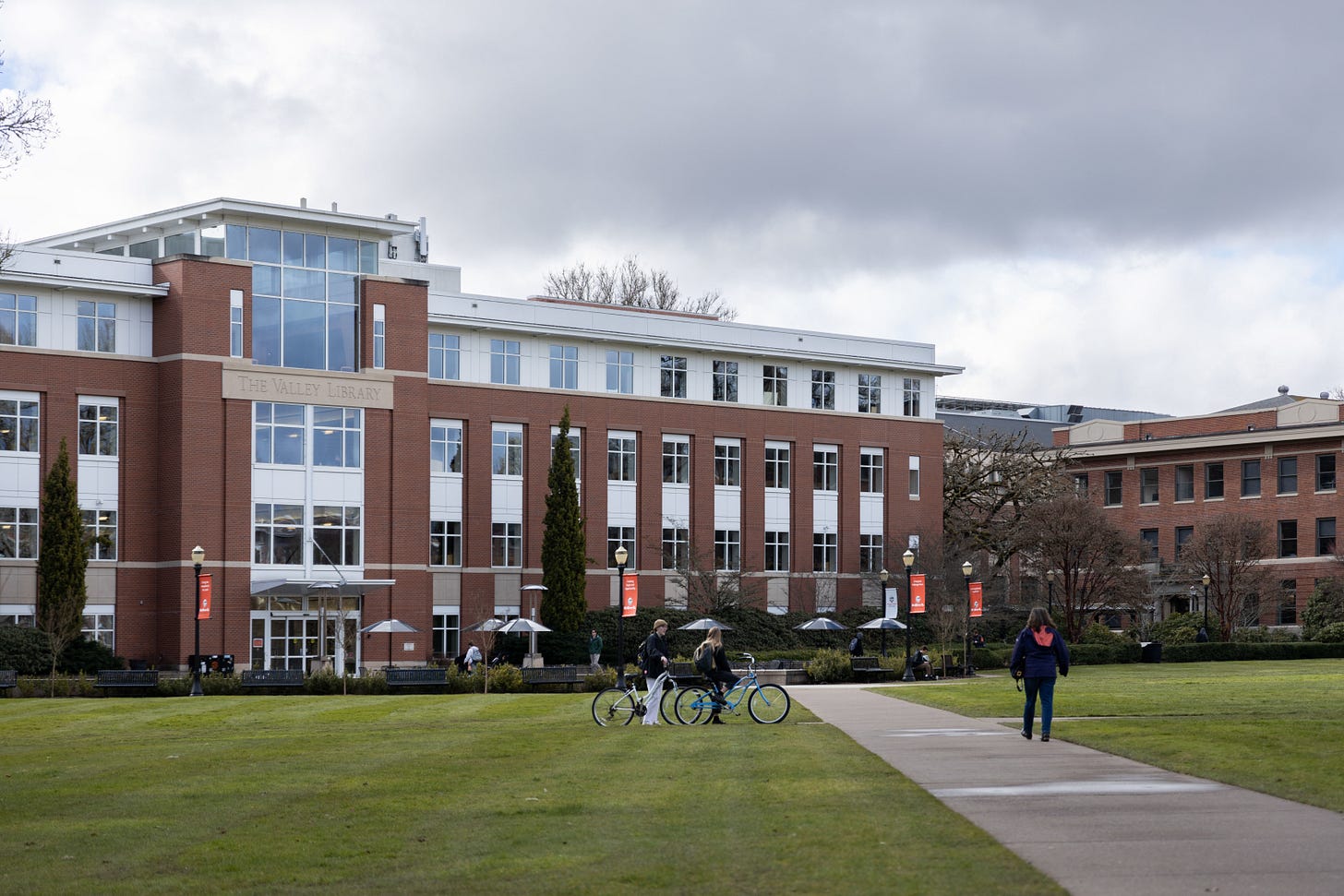Three Very Different Public Colleges
Arizona State, Oregon State, and Florida State couldn’t be more different in admissions selectivity, costs, vibes, and graduation rates. Yet, their long-term earnings outcomes are surprisingly alike.
One of the strengths of the higher education system in the USA is its variety.
There’s a college (maybe more than one) that is “right” for every college-bound student.
The difficulty lies in finding matches.
Let me give a concrete example using three different public colleges with similar sounding names.
Arizona State University (ASU)
Oregon State University (OSU)
Florida State University (FSU)
Many of us would assume that universities with “State” in their name are broadly similar… large public schools with comparable admissions, costs, and campus experiences.
But in reality these schools are wildly different in how hard they are to get into, what they cost, and what life is like once you’re there.
If you base your college list only on name recognition or assumptions, you could overlook better-fit options or misunderstand what a school will actually be like.
1. Admissions
Acceptance Rates
ASU: 88% (63,756 admitted of 70,928 applicants)
In-state: 92% (17,519 admitted of 19,121 applicants)
Out-of-State: 89% (38,249 admitted of 42,895 applicants)
OSU: 77% (23,418 admitted of 30,293 applicants)
In-state: 85% (7,298 admitted of 8,582 applicants)
Out-of-State: 77% (15,681 admitted of 20,268 applicants)
FSU: 24% (18,954 admitted of 78,272 applicants)
In-state: 32% (13,108 admitted of 41,156 applicants)
Out-of-State: 17% (5,308 of 32,018 applicants)
Middle 50% SAT/ACT (Enrolled First-Year Students)
ASU: Didn’t publish this data last year
OSU: SAT 1160–1390; ACT 24–31
Only 10% of enrolled students submitted SAT, 4% submitted ACT
FSU: SAT 1290–1400; ACT 29–32
64% of enrolled students submitted SAT; 36% submitted ACT
Test Policy
ASU: Test-optional
OSU: Test-optional
FSU: Test-required (SAT or ACT mandatory for admission)
Average GPA (this is most likely weighted)
ASU: 3.5
37% of students had a GPA of 3.75 or higher
15% of students were in the bottom half of their graduating HS class
OSU: 3.7
51% of students had a GPA of 3.75 or higher
14% of students were in the bottom half of their graduating HS class
FSU: 4.26 (3.71 unweighted)
51% of students had a GPA of 3.75 or higher
1.6% of students were in the bottom half of their graduating HS class
Percent of Out-of-State Students Enrolled
ASU: 31%
OSU: 46%
FSU: 20%
Notable Differences
ASU offers assured admission for in-state students meeting GPA/class rank benchmarks and is home to the well-regarded Barrett Honors College. OSU uses holistic review and participates in the Western Undergraduate Exchange (WUE) out-of-state discounted tuition program for some majors. FSU is much more selective, with required testing and a competitive honors program.
Takeaway
These schools live in different admissions worlds.
ASU is open to a wide range of students, especially in-state applicants who meet GPA or class rank thresholds.
OSU sits in the middle—more selective than ASU but still broadly accessible, and its WUE program is a draw for many out-of-state students.
FSU is an entirely different conversation: highly selective, test-required, and admitting only a small fraction of out-of-state applicants.
FSU is a reach for almost everyone out-of-state, OSU is a realistic option for strong students, and ASU is accessible to most who meet baseline criteria.
2. Cost & Value
Tuition & Fees (2024–25)
ASU: In-state $11,478; Out-of-state $32,394
OSU: In-state $12,675; Out-of-state $37,860; WUE $18,068
FSU: In-state $4,640; Out-of-state $19,806
Room & Board
ASU: $16,712
OSU: $18,168
FSU: $13,474
Average Non-Need Based Aid (aka Scholarship)
ASU: $8,687
36% of non-need freshman received a scholarship
OSU: $9,250
42% of non-need freshman received a scholarship
FSU: $4,447
14% of non-need freshman received a scholarship
Special Programs
ASU: Strong merit aid, including for out-of-state students.
OSU: WUE tuition discount for eligible students from participating western states/majors.
FSU: Bright Futures can nearly cover tuition for qualifying Florida residents.
Takeaway
Cost changes dramatically depending on where you live.
For Florida residents, FSU is almost unbeatable on price, and Bright Futures can make it close to free. This helps to explain why FSU is so competitive to get into… it’s a great deal for in-state students.
And, even FSU’s out-of-state cost makes it attractive to some students - e.g. FSU out-of-state is $41K while UC Santa Barbara is $78K and University of Michigan is $84K / year!
OSU’s WUE discount can be a game-changer for students from participating western states - sometimes bringing the cost below ASU.
ASU’s generous merit aid can shrink the out-of-state gap for strong applicants.
The big takeaway is don’t look at sticker prices in isolation.
Your actual cost will depend on residency, merit aid, and whether you qualify for special programs.
3. Graduation & Retention
First-Year Retention
ASU: 87%
OSU: 88%
FSU: 96%
4-Year Graduation Rate
ASU: 56%
OSU: 47%
FSU: 74%
6-Year Graduation Rate
ASU: 70%
OSU: 70%
FSU: 86%
Takeaway
FSU’s retention and graduation rates are exceptional. Students not only stay but also finish on time at rates that beat most public universities.
I think there is a reasonable discussion to be had about whether FSU’s successes are because of the school or because the school only admits high-calibre students (it’s probably a bit of both).
ASU and OSU lag in four-year completion, which may reflect more students switching majors, working while in school, or taking advantage of co-ops and internships. It may also, again, be a factor of ASU and OSU admitting more students who may not be as strong academically (e.g. providing more opportunity).
If graduating in four years is a priority, the numbers suggest FSU has the edge, but all three will get most students across the finish line if they persist.
4. Campus & Culture
Arizona State University (Tempe)
Urban setting in Phoenix metro; 642-acre campus. Known for innovation, research, arts, and its Barrett Honors College, which may be the best at any public college in the USA. Also has a large online education offering, which in recent years has meant that many on-campus students have ended up taking some online courses.
Oregon State University (Corvallis)
Classic college-town feel in a 420-acre arboretum-like campus in Oregon’s Willamette Valley. Over 400 student organizations, strong outdoor culture, and active student media.
Florida State University (Tallahassee)
Historic campus in Florida’s capital city, 486 acres. More than 750 student organizations, ranked top in Florida and #6 nationally for student life. Exceptional retention and graduation rates signal strong academic support.
Takeaway
The vibes could not be more different.
ASU offers a sprawling, urban, innovation-driven experience with a major honors college and lots of flexibility. But, sometimes that means taking online classes even while living on campus. Ample sunshine though!
OSU leans into the quintessential college-town feel, with an outdoorsy, tight-knit community. Expect lots of rain and cloudy days. It’s also a much smaller student population.
FSU blends tradition, big-school spirit, and a capital-city location with standout student life rankings. Student life and athletic events are top-notch.
5. ROI & Outcomes
Median Earnings 10 Years After Entry
ASU: $62,668
OSU: $64,010
FSU: $61,675
20-Year NPV
ASU: $492,000
OSU: $464,000
FSU: $460,000
Takeaway
I think this may be the most surprising statistic to many: long-term earnings are almost identical across the three schools.
Graduates from each make roughly the same ten years out, and 20-year net present values are within $30K of each other.
This tells you that prestige and selectivity aren’t the only drivers of financial payoff.
If all else is equal, pick based on cost, academic fit, and the environment where you’ll thrive, because the earnings data says you can get to a similar place from any of them.
Putting It All Together
“State” in the name doesn’t necessarily mean similar.
Admissions competitiveness, cost, student outcomes, and campus experience vary dramatically.
ASU is broadly accessible with strong merit aid and a large, dynamic campus.
OSU blends a classic college-town setting with access-oriented admissions and WUE discounts.
FSU is highly selective with exceptional retention and graduation rates.
Interestingly, ROI across these three schools is surprisingly similar, which means fit—academic, financial, and cultural—should drive decision-making more than brand familiarity alone.
APPENDIX: Data Sources
You might be wondering where this data came from. Sadly, it requires quite a bit of cobbling things together.
College Scorecard, e.g. OSU
Google searches and summaries for campus life and culture




